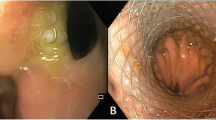Abstract
The endoscopic management of four selected patients with inveterate esophageal perforations or leaks is presented. One patient had a perforation of the cervical esophagus following endoscopic removal of a foreign body already treated with surgical drainage; two patients had a leak following diverticulectomy and esophagogastrostomy, respectively, persistent after multiple surgical repairs; the last patient had a spontaneous perforation of the thoracic esophagus persistent after two transthoracic repairs. The mean time elapsed between the diagnosis of perforation and the endoscopic treatment was 19 days. In one patient, transesophageal drainage of a mediastinal abscess was performed. In the other three patients, a stent was placed to seal the leak in combination with gastric and esophageal aspiration. Two of these patients underwent endoscopy in critical condition and could have not been candidates for major surgical procedures. All patients received enteral nutrition. No morbidity or mortality related to the endoscopic procedure was recorded; the treatment was effective in all patients who recovered and resumed oral feeding within 3 weeks. We conclude that endoscopic transesophageal drainage and stenting are effective procedures in the management of patients with inveterate esophageal perforations or leaks.
Similar content being viewed by others
References
Bardini R, Bonavina L, Pavanello M, Asolati M, Peracchia A (1992) Temporary double exclusion of the perforated esophagus using absorbable staples. Ann Thorac Surg 54: 1165–1167
Bruckner M, Grimm H, Nam VC, Soehendra N (1991) Experience with a transnasally fixed endoprosthesis for treating esophageal anastomotic leakage. Surg Endosc 5: 185–188
Cameron JL, Kieffer RF, Hendrix TR, Mehigan DG, Baker RR (1979) Selective nonoperative management of contained intrathoracic esophageal disruptions. Ann Thorac Surg 27: 404–408
Cusumano A, Ruol A, Segalin A, Norberto L, Baessato M, Peracchia A (1992) Push through intubation: effective palliation in 409 patients with cancer of the esophagus and cardia. Ann Thorac Surg 53: 1020–1014
DeMeester TR (1986) Perforation of the esophagus [Editorial]. Ann Thorac Surg 42: 231–232
Flynn AE, Verrier ED, Way LW, Thomas AN, Pellegrini CA (1989) Esophageal perforation. Arch Surg 124: 1211–1215
Jones WJ, Ginsberg RJ (1992) Esophageal perforation: a continuing challenge. Ann Thorac Surg 53: 534–543
Jorgensen JO, Hunt DR (1993) Endoscopic drainage of esophageal suture lines leaks. Am J Surg 165: 362–364
Mc Namee CJ, Meyns B, Pagliero KM (1991) New method for dealing with late-presenting spontaneous esophageal ruptures. Ann Thorac Surg 52: 151–153
Ofek B, Hoffman J (1986) Non-invasive treatment of esophagogastric anastomoitc leakage. Arch Surg 121: 124
Sandrasagra FA, English TAH, Milstein BB (1978) Intubation in the management of perforated esophagus with stricture. Ann Thorac Surg 25: 399–401
Sargeant IR, Thrope S, Bown SG (1992) Cuffed esophageal prosthesis: a useful device in desperate situation in esophageal malignancy. Gastrointest Endosc 38: 669–675
Author information
Authors and Affiliations
Rights and permissions
About this article
Cite this article
Segalin, A., Bonavina, L., Lazzerini, M. et al. Endoscopic management of inveterate esophageal perforations and leaks. Surg Endosc 10, 928–932 (1996). https://doi.org/10.1007/BF00188486
Received:
Accepted:
Issue Date:
DOI: https://doi.org/10.1007/BF00188486




